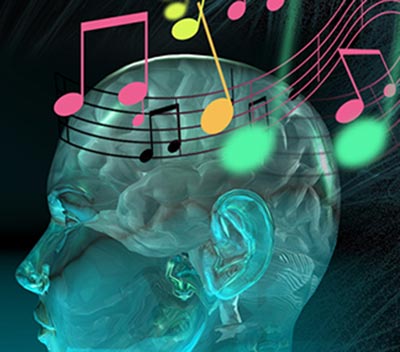Creativity is the lifeblood of artists, writers, and musicians, but creative blocks, stress, and lack of focus can hinder the creative process. Binaural Beats music can help creatives overcome these obstacles by tapping into the brain’s natural rhythms and enhancing cognitive function.
In this article, I will break down how binaural beats work, their benefits for creativity and how you can incorporate them into your creative practice.

What Are Binaural Beats?
I've covered this a bunch of times across the site, but for those who are new here, I'll recap:
Binaural beats are an auditory illusion created when two slightly different frequencies are played in each ear. The brain perceives the difference between these frequencies as a third tone (which is the mathematical difference between the two), encouraging the brain to follow along and sync to this new frequency. This is known as “frequency following response”.
This phenomenon, known as brainwave entrainment, can guide the mind into different states of consciousness, such as deep relaxation, heightened focus, or creative flow.
Different frequencies correspond to different brainwave states. Here's a rough guide, but bear in mind there can be benefit overlap between states, and there are specific frequencies within each state that may produce specific effects.
- Delta (0.5–4 Hz): Deep sleep and subconscious processing
- Theta (4–8 Hz): Creativity, deep relaxation, and intuition
- Alpha (8–14 Hz): Calm focus and mindfulness
- Beta (14–30 Hz): Alertness and active thinking
- Gamma (30+ Hz): High-level cognition and inspiration
For creatives, Theta and Alpha waves are particularly beneficial for unlocking inspiration, enhancing visualization, and maintaining a flow state.
How Binaural Beats Enhance Creativity
1. Overcoming Creative Blocks
Writer’s block, artist’s block, and general creative stagnation often stem from stress, self-doubt, or overthinking. Binaural beats can help:
- Shift the brain into a relaxed but alert state, allowing ideas to flow more naturally.
- Reduce anxiety and self-criticism, making it easier to take creative risks.
- Encourage subconscious problem-solving, helping breakthroughs emerge effortlessly.
2. Enhancing Focus and Deep Work
Distractions are one of the biggest creativity killers. Binaural beats can help maintain concentration by:
- Promoting a state of deep focus through alpha and low beta frequencies.
- Minimizing mental clutter, making it easier to sustain attention on a project.
- Encouraging a sense of time distortion, allowing you to get lost in your work for hours.
3. Stimulating Imagination and Idea Generation
Creativity isn’t just about execution, it’s about coming up with unique ideas. Binaural beats assist by:
- Activating theta waves, which are associated with daydreaming, visualization, and imaginative thinking.
- Helping creatives access their subconscious mind, where unexpected connections and insights are formed.
- Encouraging abstract and divergent thinking, making brainstorming sessions more productive.
4. Reducing Performance Anxiety and Self-Doubt
Many creatives struggle with perfectionism and fear of judgment. Binaural beats can help:
- Lower stress levels by reducing cortisol, the stress hormone.
- Increase dopamine production, boosting motivation and joy in the creative process.
- Shift the mind into a state of relaxed confidence, making performance and improvisation feel more natural.
5. Supporting Rest and Recovery
Rest is just as important as active creativity. Listening to delta and theta binaural beats before bed or during breaks can:
- Improve sleep quality, leading to better cognitive function and mood.
- Encourage lucid dreaming, a powerful tool for artistic inspiration.
- Allow the brain to process creative ideas subconsciously, leading to new insights upon waking.
How to Use Binaural Beats for Creativity
1. Choose the Right Frequency
- For brainstorming and idea generation: Theta waves (4–8 Hz)
- For deep focus and productivity: Alpha or low Beta waves (8–14 Hz)
- For relaxation and overcoming stress: Delta or Theta waves (0.5–8 Hz). Delta is usually associated with sleep and pain relief.
2. Use Headphones
Since binaural beats work by sending different frequencies to each ear, headphones are necessary for the effect to take place. You can use any headphones, but the closed-back over-the-ear type work very well.
3. Create a Ritual
Incorporate binaural beats into your daily creative routine by:
- Listening for 30 minutes before starting a creative session.
- Using them during warm-up exercises like free-writing, sketching, or jamming.
- Playing them while you engage in your creative endeavor.
4. Experiment with Different Tracks
Everyone’s brain responds differently to frequencies because brainwave entrainment depends on factors like personal sensitivity, mood, and external environment. Some may find Theta waves unlock deep creativity, while others might thrive on the heightened cognitive performance of Beta waves. The key is to experiment and observe what enhances your unique creative process. Try various binaural beats programs to find what works best for your creative needs.
You can experiment with Alpha waves (8-14 Hz) for a relaxed but alert state, ideal for brainstorming, focus, and creative flow. Theta waves (4-8 Hz) promote deep imagination and insight, making them great for artists, writers, and musicians seeking inspiration. Beta waves (14-30 Hz) help with problem-solving, and structured thinking— great for tasks requiring logical creativity, such as writing or design work. Gamma waves (30+ Hz) enhance cognitive function and peak mental performance, which can be beneficial for high-level creative work.
——
Binaural Beats music can be a powerful tool for artists, writers, and musicians seeking to enhance their creativity, overcome blocks, and deepen their artistic flow. By incorporating them into your practice, you can unlock new levels of inspiration and productivity while reducing stress and mental fatigue.



Chris says
Thanks to you Lawrence, I became a Binaural Beats Junkie. Lol! Truly am grateful for your work here. These binaural beats audio have been incredibly life-changing!
bbfreak says
Haha, love that! Glad they’ve made such a difference for you. Keep enjoying the journey! 🚀💙